BSBLED802 - Lead Learning Strategy Implementation Report
VerifiedAdded on 2022/11/18
|33
|6720
|293
Report
AI Summary
This report provides a detailed analysis of organizational strategy and learning, focusing on the BSBLED802 unit. It explores various aspects, including international e-learning compliance systems, TEQSA's risk assessment, legal provisions related to marketing, and the role of technology. The report delves into organizational learning theories, such as single-loop, double-loop, and deutero learning, and their practical applications. It examines the requirements for organizational learning strategies, aligning them with human resources and technological needs. Furthermore, the report includes examples and case studies, providing practical insights into the implementation of learning strategies within organizations. The document also presents sample meeting minutes, communication templates, and a detailed overview of learning strategy implementation processes, making it a comprehensive resource for students and professionals alike.
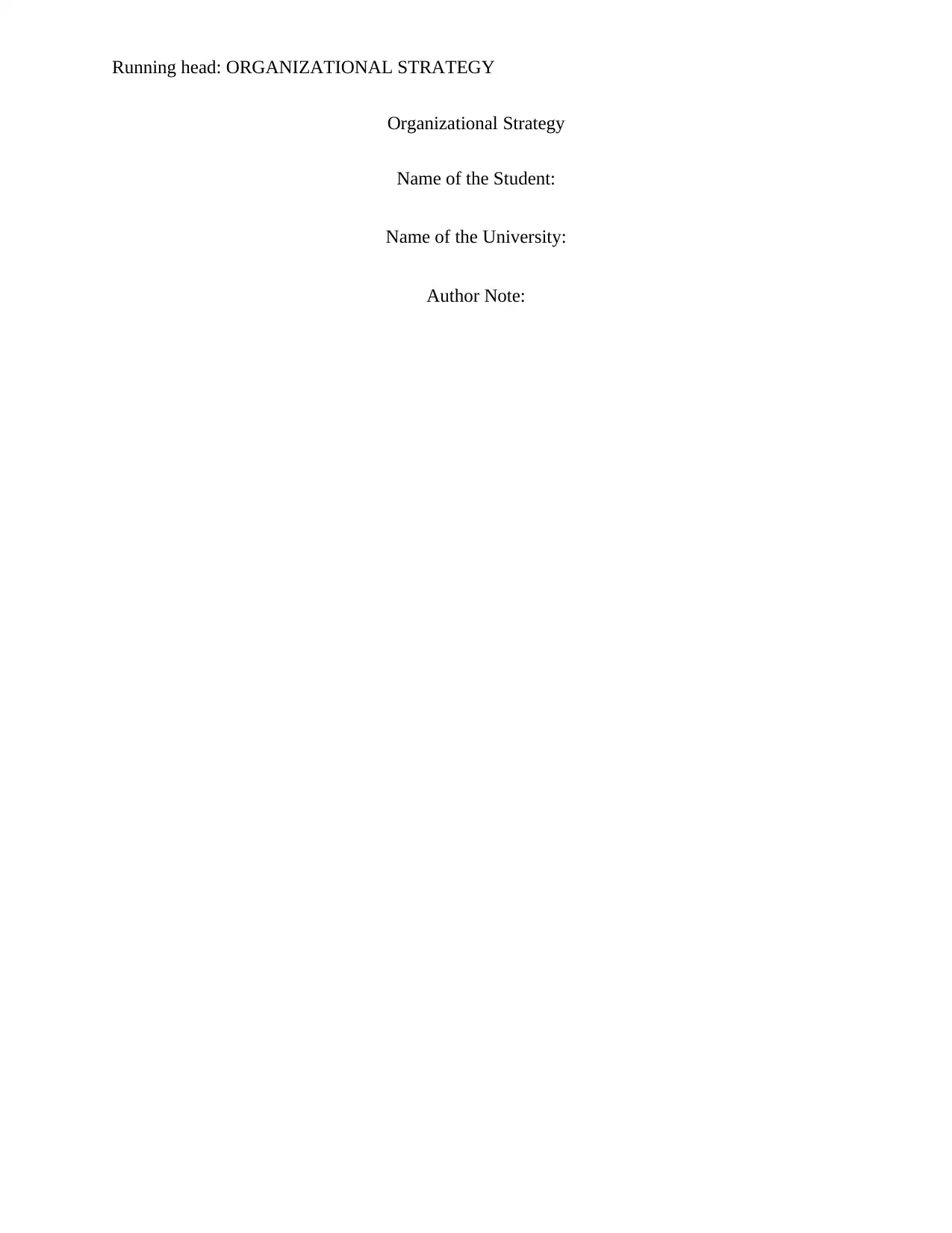
Running head: ORGANIZATIONAL STRATEGY
Organizational Strategy
Name of the Student:
Name of the University:
Author Note:
Organizational Strategy
Name of the Student:
Name of the University:
Author Note:
Paraphrase This Document
Need a fresh take? Get an instant paraphrase of this document with our AI Paraphraser
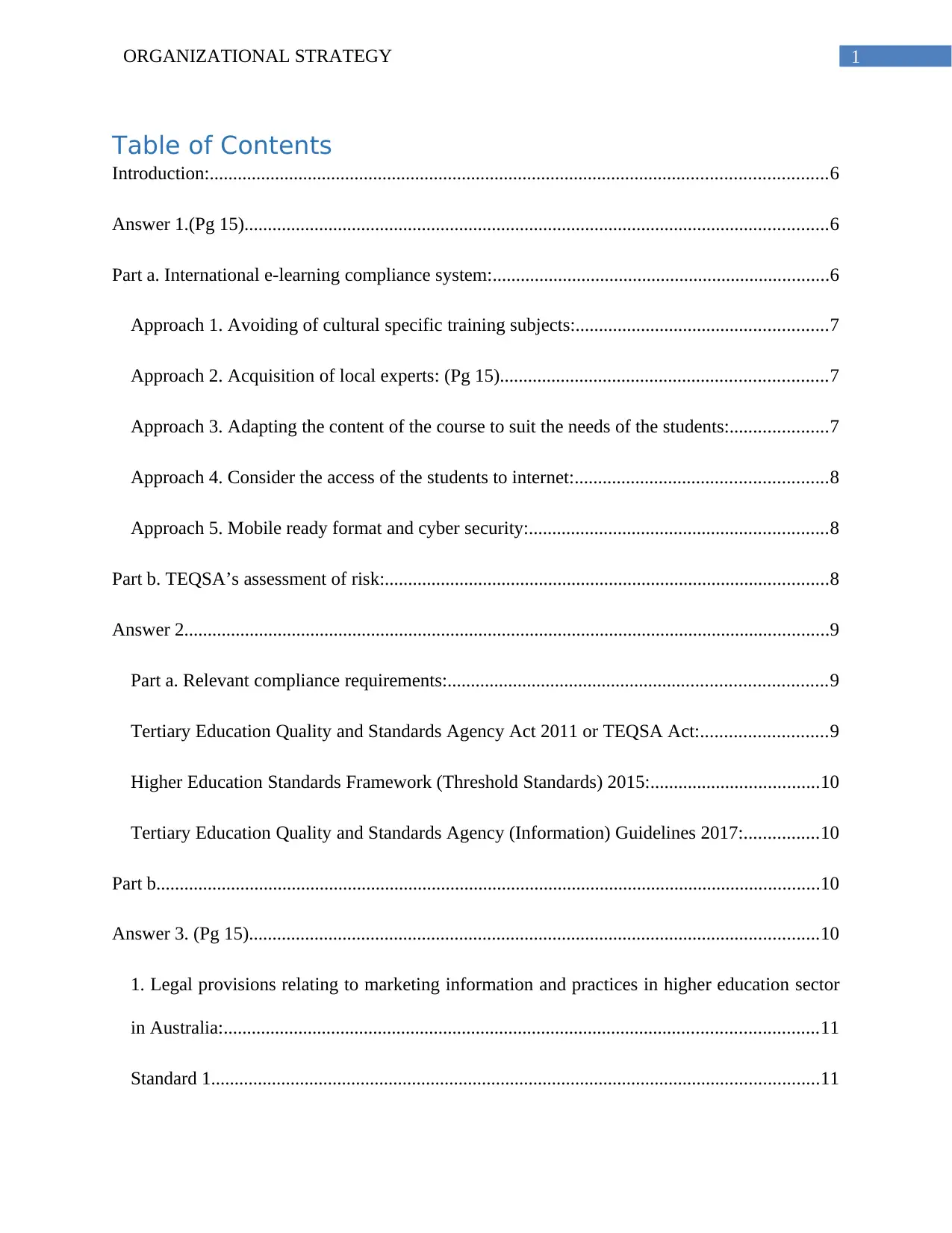
1ORGANIZATIONAL STRATEGY
Table of Contents
Introduction:....................................................................................................................................6
Answer 1.(Pg 15).............................................................................................................................6
Part a. International e-learning compliance system:........................................................................6
Approach 1. Avoiding of cultural specific training subjects:......................................................7
Approach 2. Acquisition of local experts: (Pg 15)......................................................................7
Approach 3. Adapting the content of the course to suit the needs of the students:.....................7
Approach 4. Consider the access of the students to internet:......................................................8
Approach 5. Mobile ready format and cyber security:................................................................8
Part b. TEQSA’s assessment of risk:...............................................................................................8
Answer 2..........................................................................................................................................9
Part a. Relevant compliance requirements:.................................................................................9
Tertiary Education Quality and Standards Agency Act 2011 or TEQSA Act:...........................9
Higher Education Standards Framework (Threshold Standards) 2015:....................................10
Tertiary Education Quality and Standards Agency (Information) Guidelines 2017:................10
Part b..............................................................................................................................................10
Answer 3. (Pg 15)..........................................................................................................................10
1. Legal provisions relating to marketing information and practices in higher education sector
in Australia:...............................................................................................................................11
Standard 1..................................................................................................................................11
Table of Contents
Introduction:....................................................................................................................................6
Answer 1.(Pg 15).............................................................................................................................6
Part a. International e-learning compliance system:........................................................................6
Approach 1. Avoiding of cultural specific training subjects:......................................................7
Approach 2. Acquisition of local experts: (Pg 15)......................................................................7
Approach 3. Adapting the content of the course to suit the needs of the students:.....................7
Approach 4. Consider the access of the students to internet:......................................................8
Approach 5. Mobile ready format and cyber security:................................................................8
Part b. TEQSA’s assessment of risk:...............................................................................................8
Answer 2..........................................................................................................................................9
Part a. Relevant compliance requirements:.................................................................................9
Tertiary Education Quality and Standards Agency Act 2011 or TEQSA Act:...........................9
Higher Education Standards Framework (Threshold Standards) 2015:....................................10
Tertiary Education Quality and Standards Agency (Information) Guidelines 2017:................10
Part b..............................................................................................................................................10
Answer 3. (Pg 15)..........................................................................................................................10
1. Legal provisions relating to marketing information and practices in higher education sector
in Australia:...............................................................................................................................11
Standard 1..................................................................................................................................11
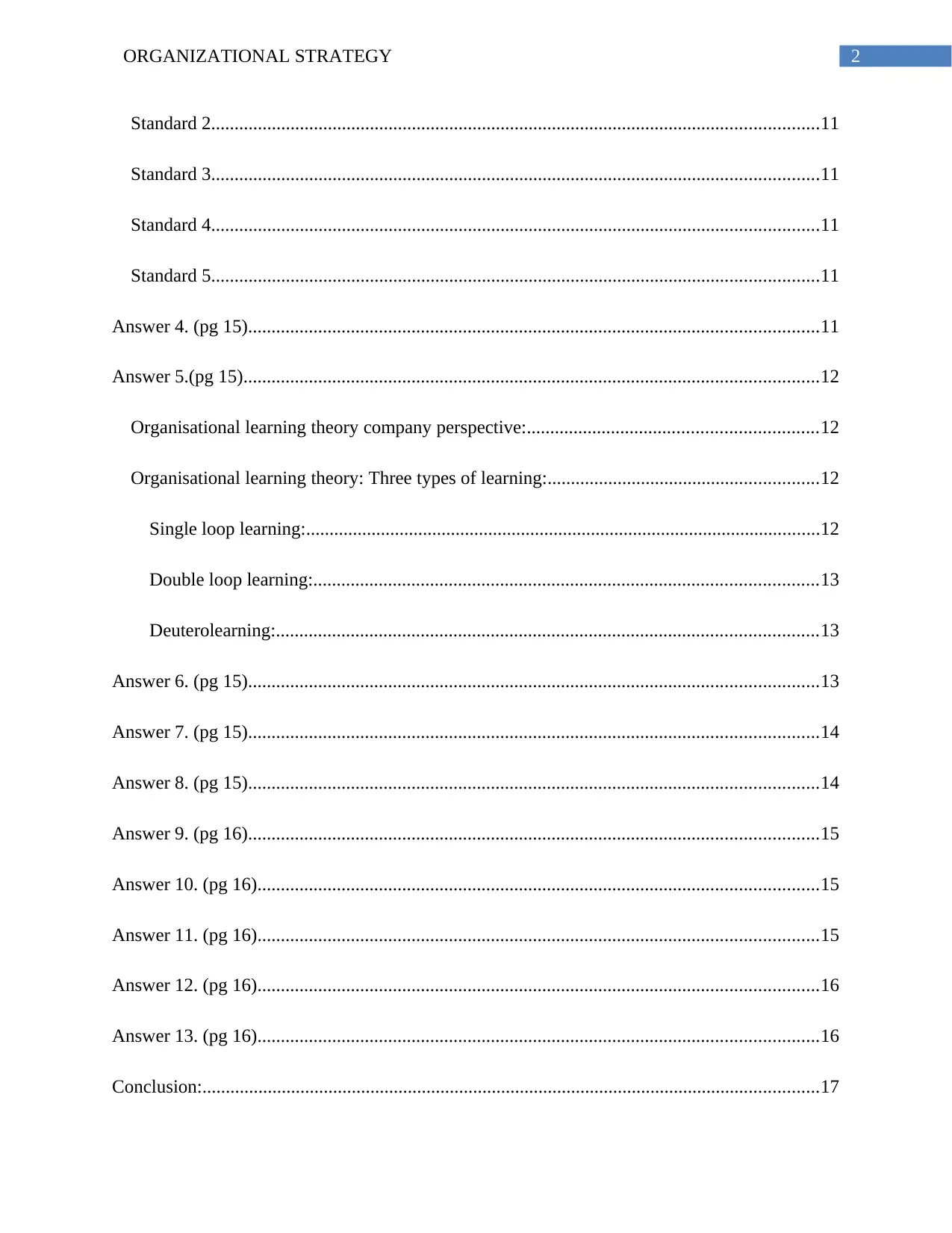
2ORGANIZATIONAL STRATEGY
Standard 2..................................................................................................................................11
Standard 3..................................................................................................................................11
Standard 4..................................................................................................................................11
Standard 5..................................................................................................................................11
Answer 4. (pg 15)..........................................................................................................................11
Answer 5.(pg 15)...........................................................................................................................12
Organisational learning theory company perspective:..............................................................12
Organisational learning theory: Three types of learning:..........................................................12
Single loop learning:..............................................................................................................12
Double loop learning:............................................................................................................13
Deuterolearning:....................................................................................................................13
Answer 6. (pg 15)..........................................................................................................................13
Answer 7. (pg 15)..........................................................................................................................14
Answer 8. (pg 15)..........................................................................................................................14
Answer 9. (pg 16)..........................................................................................................................15
Answer 10. (pg 16)........................................................................................................................15
Answer 11. (pg 16)........................................................................................................................15
Answer 12. (pg 16)........................................................................................................................16
Answer 13. (pg 16)........................................................................................................................16
Conclusion:....................................................................................................................................17
Standard 2..................................................................................................................................11
Standard 3..................................................................................................................................11
Standard 4..................................................................................................................................11
Standard 5..................................................................................................................................11
Answer 4. (pg 15)..........................................................................................................................11
Answer 5.(pg 15)...........................................................................................................................12
Organisational learning theory company perspective:..............................................................12
Organisational learning theory: Three types of learning:..........................................................12
Single loop learning:..............................................................................................................12
Double loop learning:............................................................................................................13
Deuterolearning:....................................................................................................................13
Answer 6. (pg 15)..........................................................................................................................13
Answer 7. (pg 15)..........................................................................................................................14
Answer 8. (pg 15)..........................................................................................................................14
Answer 9. (pg 16)..........................................................................................................................15
Answer 10. (pg 16)........................................................................................................................15
Answer 11. (pg 16)........................................................................................................................15
Answer 12. (pg 16)........................................................................................................................16
Answer 13. (pg 16)........................................................................................................................16
Conclusion:....................................................................................................................................17
⊘ This is a preview!⊘
Do you want full access?
Subscribe today to unlock all pages.

Trusted by 1+ million students worldwide
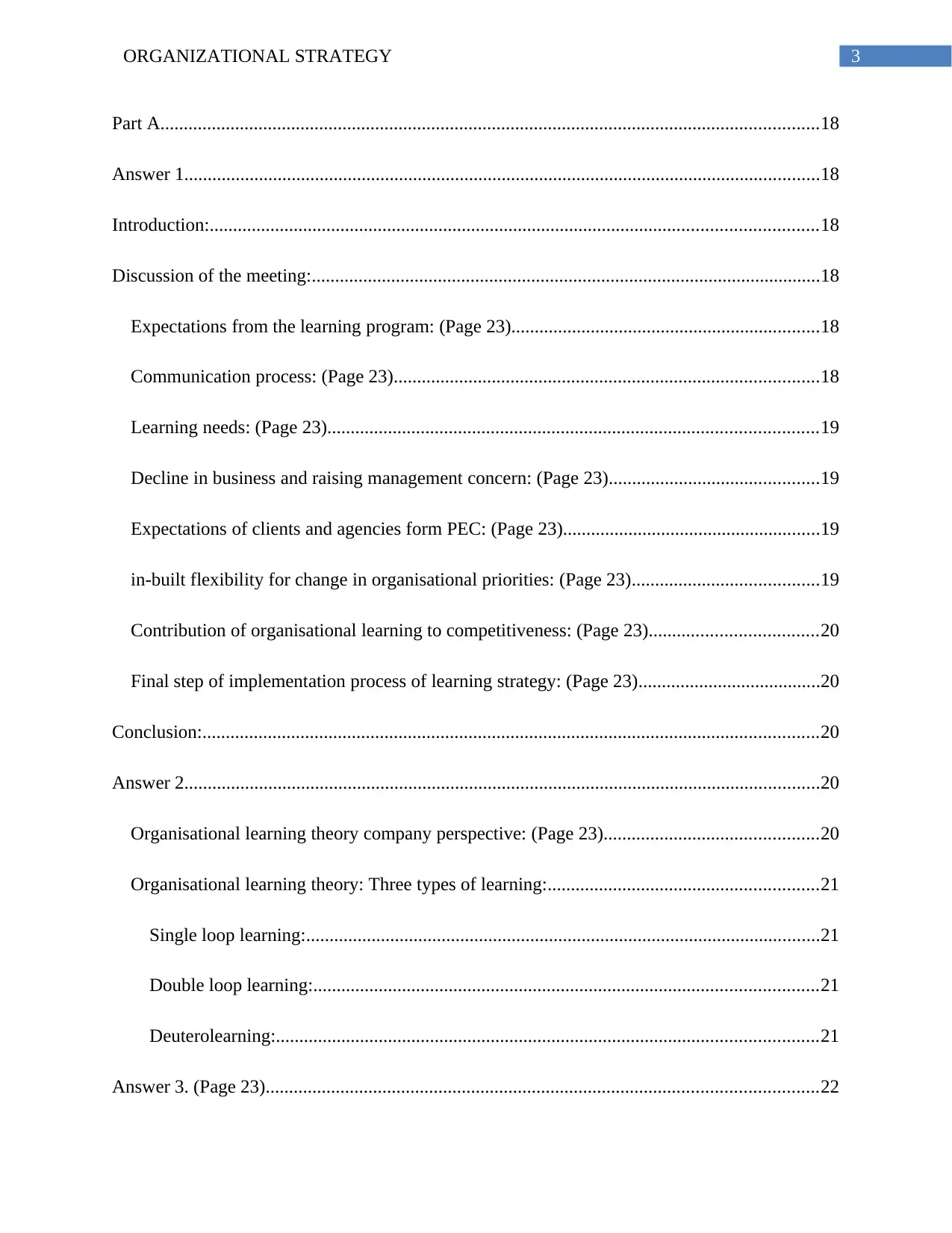
3ORGANIZATIONAL STRATEGY
Part A.............................................................................................................................................18
Answer 1........................................................................................................................................18
Introduction:..................................................................................................................................18
Discussion of the meeting:.............................................................................................................18
Expectations from the learning program: (Page 23)..................................................................18
Communication process: (Page 23)...........................................................................................18
Learning needs: (Page 23).........................................................................................................19
Decline in business and raising management concern: (Page 23).............................................19
Expectations of clients and agencies form PEC: (Page 23).......................................................19
in-built flexibility for change in organisational priorities: (Page 23)........................................19
Contribution of organisational learning to competitiveness: (Page 23)....................................20
Final step of implementation process of learning strategy: (Page 23).......................................20
Conclusion:....................................................................................................................................20
Answer 2........................................................................................................................................20
Organisational learning theory company perspective: (Page 23)..............................................20
Organisational learning theory: Three types of learning:..........................................................21
Single loop learning:..............................................................................................................21
Double loop learning:............................................................................................................21
Deuterolearning:....................................................................................................................21
Answer 3. (Page 23)......................................................................................................................22
Part A.............................................................................................................................................18
Answer 1........................................................................................................................................18
Introduction:..................................................................................................................................18
Discussion of the meeting:.............................................................................................................18
Expectations from the learning program: (Page 23)..................................................................18
Communication process: (Page 23)...........................................................................................18
Learning needs: (Page 23).........................................................................................................19
Decline in business and raising management concern: (Page 23).............................................19
Expectations of clients and agencies form PEC: (Page 23).......................................................19
in-built flexibility for change in organisational priorities: (Page 23)........................................19
Contribution of organisational learning to competitiveness: (Page 23)....................................20
Final step of implementation process of learning strategy: (Page 23).......................................20
Conclusion:....................................................................................................................................20
Answer 2........................................................................................................................................20
Organisational learning theory company perspective: (Page 23)..............................................20
Organisational learning theory: Three types of learning:..........................................................21
Single loop learning:..............................................................................................................21
Double loop learning:............................................................................................................21
Deuterolearning:....................................................................................................................21
Answer 3. (Page 23)......................................................................................................................22
Paraphrase This Document
Need a fresh take? Get an instant paraphrase of this document with our AI Paraphraser

4ORGANIZATIONAL STRATEGY
Answer 4. (Page 23)......................................................................................................................22
Answer 5. (Page 23)......................................................................................................................22
Part B.............................................................................................................................................24
Answer 1. (Page 24)......................................................................................................................24
Answer 2........................................................................................................................................24
Answer 3. (Page 24)......................................................................................................................25
Answer 4. (Page 24)......................................................................................................................25
Answer 5. (Page 25)......................................................................................................................26
Answer 6. (Page 25)......................................................................................................................26
Answer 1. (Page 32)......................................................................................................................28
Answer 2: (Page 32)......................................................................................................................28
Answer 3. (Page 32)......................................................................................................................28
Answer 4. (Page 32)......................................................................................................................29
Answer 5: (Page 32)......................................................................................................................29
To: …………………(Official email ids of the departmental heads)............................................29
From…………………….(sender).................................................................................................29
Dear Sir/Madam,............................................................................................................................29
Please find attached the details of the new learning strategies and the new location as record
keeping systems of PEC Consultants. The same is for your kind perusal and notice. Please
archive the old learning strategy for your future references..........................................................29
Answer 4. (Page 23)......................................................................................................................22
Answer 5. (Page 23)......................................................................................................................22
Part B.............................................................................................................................................24
Answer 1. (Page 24)......................................................................................................................24
Answer 2........................................................................................................................................24
Answer 3. (Page 24)......................................................................................................................25
Answer 4. (Page 24)......................................................................................................................25
Answer 5. (Page 25)......................................................................................................................26
Answer 6. (Page 25)......................................................................................................................26
Answer 1. (Page 32)......................................................................................................................28
Answer 2: (Page 32)......................................................................................................................28
Answer 3. (Page 32)......................................................................................................................28
Answer 4. (Page 32)......................................................................................................................29
Answer 5: (Page 32)......................................................................................................................29
To: …………………(Official email ids of the departmental heads)............................................29
From…………………….(sender).................................................................................................29
Dear Sir/Madam,............................................................................................................................29
Please find attached the details of the new learning strategies and the new location as record
keeping systems of PEC Consultants. The same is for your kind perusal and notice. Please
archive the old learning strategy for your future references..........................................................29
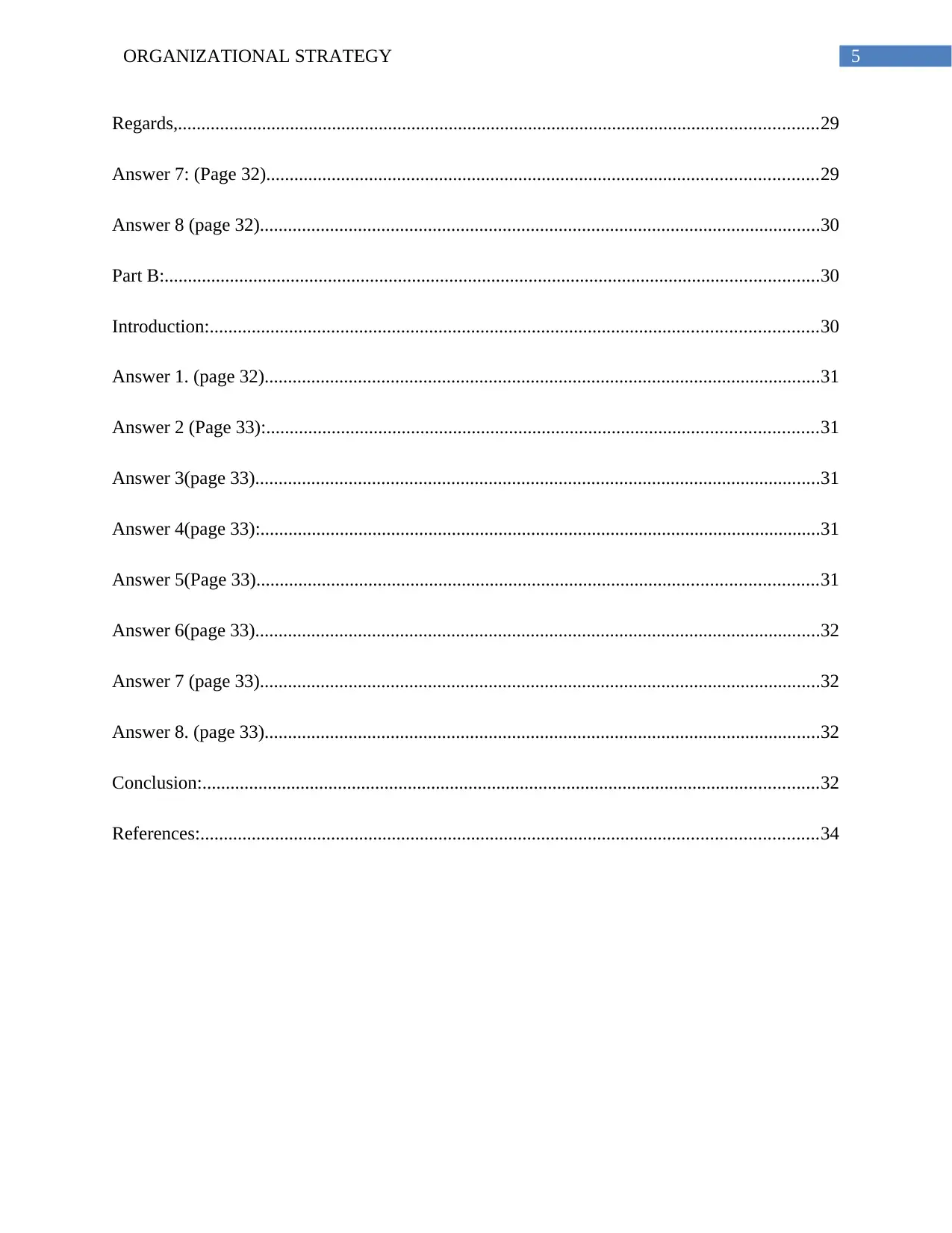
5ORGANIZATIONAL STRATEGY
Regards,.........................................................................................................................................29
Answer 7: (Page 32)......................................................................................................................29
Answer 8 (page 32)........................................................................................................................30
Part B:............................................................................................................................................30
Introduction:..................................................................................................................................30
Answer 1. (page 32).......................................................................................................................31
Answer 2 (Page 33):......................................................................................................................31
Answer 3(page 33).........................................................................................................................31
Answer 4(page 33):........................................................................................................................31
Answer 5(Page 33)........................................................................................................................31
Answer 6(page 33).........................................................................................................................32
Answer 7 (page 33)........................................................................................................................32
Answer 8. (page 33).......................................................................................................................32
Conclusion:....................................................................................................................................32
References:....................................................................................................................................34
Regards,.........................................................................................................................................29
Answer 7: (Page 32)......................................................................................................................29
Answer 8 (page 32)........................................................................................................................30
Part B:............................................................................................................................................30
Introduction:..................................................................................................................................30
Answer 1. (page 32).......................................................................................................................31
Answer 2 (Page 33):......................................................................................................................31
Answer 3(page 33).........................................................................................................................31
Answer 4(page 33):........................................................................................................................31
Answer 5(Page 33)........................................................................................................................31
Answer 6(page 33).........................................................................................................................32
Answer 7 (page 33)........................................................................................................................32
Answer 8. (page 33).......................................................................................................................32
Conclusion:....................................................................................................................................32
References:....................................................................................................................................34
⊘ This is a preview!⊘
Do you want full access?
Subscribe today to unlock all pages.

Trusted by 1+ million students worldwide

6ORGANIZATIONAL STRATEGY
Introduction:
Operations of the organisations have become extremely vast and complex. The
organisations today in order to operate effectively have to comply with several laws and
legislations. They have to ensure continuous improvement in the operations by carrying out
continuous training and development among employees. The organisations in the pursuit of
bringing about improvement in the skills and competencies of employees, implement training
and development as the organisational learning strategy. The managers both at the apex level and
middle levels evaluate the performance of the organisations on regular basis. This brings the
managers to assess the performance of the employees which in turn leads them to assess the
effectiveness of organisational learning strategies implemented to bring about employee skill
development. The aim of the report would be to delve into these three concepts namely,
organisational evaluation strategies, organisational learning strategies and legal compliance to
applicable to registered training organisations. The organisation which the research would
consider would be Tertiary Education Quality and Standard Agency or TEQSA, Government of
Australia. The body oversees, regulates and enforces quality standards in the higher education
sector in Australia (Teqsa.gov.au, 2019).
Answer 1.(Pg 15)
Part a. International e-learning compliance system:
The following are the five international e-learning compliance systems approaches used
across the globe:
Introduction:
Operations of the organisations have become extremely vast and complex. The
organisations today in order to operate effectively have to comply with several laws and
legislations. They have to ensure continuous improvement in the operations by carrying out
continuous training and development among employees. The organisations in the pursuit of
bringing about improvement in the skills and competencies of employees, implement training
and development as the organisational learning strategy. The managers both at the apex level and
middle levels evaluate the performance of the organisations on regular basis. This brings the
managers to assess the performance of the employees which in turn leads them to assess the
effectiveness of organisational learning strategies implemented to bring about employee skill
development. The aim of the report would be to delve into these three concepts namely,
organisational evaluation strategies, organisational learning strategies and legal compliance to
applicable to registered training organisations. The organisation which the research would
consider would be Tertiary Education Quality and Standard Agency or TEQSA, Government of
Australia. The body oversees, regulates and enforces quality standards in the higher education
sector in Australia (Teqsa.gov.au, 2019).
Answer 1.(Pg 15)
Part a. International e-learning compliance system:
The following are the five international e-learning compliance systems approaches used
across the globe:
Paraphrase This Document
Need a fresh take? Get an instant paraphrase of this document with our AI Paraphraser
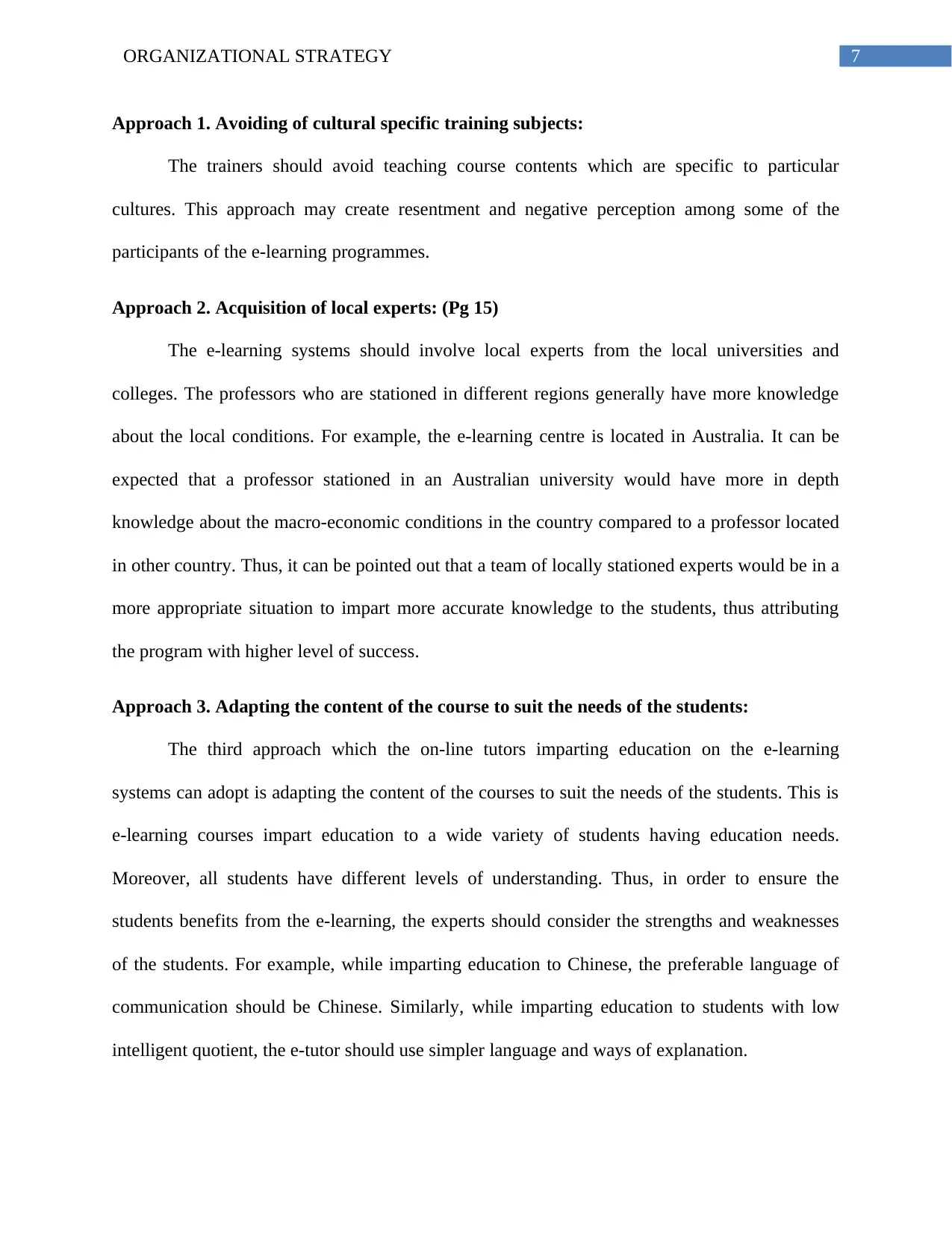
7ORGANIZATIONAL STRATEGY
Approach 1. Avoiding of cultural specific training subjects:
The trainers should avoid teaching course contents which are specific to particular
cultures. This approach may create resentment and negative perception among some of the
participants of the e-learning programmes.
Approach 2. Acquisition of local experts: (Pg 15)
The e-learning systems should involve local experts from the local universities and
colleges. The professors who are stationed in different regions generally have more knowledge
about the local conditions. For example, the e-learning centre is located in Australia. It can be
expected that a professor stationed in an Australian university would have more in depth
knowledge about the macro-economic conditions in the country compared to a professor located
in other country. Thus, it can be pointed out that a team of locally stationed experts would be in a
more appropriate situation to impart more accurate knowledge to the students, thus attributing
the program with higher level of success.
Approach 3. Adapting the content of the course to suit the needs of the students:
The third approach which the on-line tutors imparting education on the e-learning
systems can adopt is adapting the content of the courses to suit the needs of the students. This is
e-learning courses impart education to a wide variety of students having education needs.
Moreover, all students have different levels of understanding. Thus, in order to ensure the
students benefits from the e-learning, the experts should consider the strengths and weaknesses
of the students. For example, while imparting education to Chinese, the preferable language of
communication should be Chinese. Similarly, while imparting education to students with low
intelligent quotient, the e-tutor should use simpler language and ways of explanation.
Approach 1. Avoiding of cultural specific training subjects:
The trainers should avoid teaching course contents which are specific to particular
cultures. This approach may create resentment and negative perception among some of the
participants of the e-learning programmes.
Approach 2. Acquisition of local experts: (Pg 15)
The e-learning systems should involve local experts from the local universities and
colleges. The professors who are stationed in different regions generally have more knowledge
about the local conditions. For example, the e-learning centre is located in Australia. It can be
expected that a professor stationed in an Australian university would have more in depth
knowledge about the macro-economic conditions in the country compared to a professor located
in other country. Thus, it can be pointed out that a team of locally stationed experts would be in a
more appropriate situation to impart more accurate knowledge to the students, thus attributing
the program with higher level of success.
Approach 3. Adapting the content of the course to suit the needs of the students:
The third approach which the on-line tutors imparting education on the e-learning
systems can adopt is adapting the content of the courses to suit the needs of the students. This is
e-learning courses impart education to a wide variety of students having education needs.
Moreover, all students have different levels of understanding. Thus, in order to ensure the
students benefits from the e-learning, the experts should consider the strengths and weaknesses
of the students. For example, while imparting education to Chinese, the preferable language of
communication should be Chinese. Similarly, while imparting education to students with low
intelligent quotient, the e-tutor should use simpler language and ways of explanation.

8ORGANIZATIONAL STRATEGY
Approach 4. Consider the access of the students to internet:
The professors imparting education should consider the level of access to internet
students stationed in different countries. This is because the e-learning systems are dependent on
the access to internet access. For example, students in countries like the USA have more access
to the internet while students in African countries have limited access to internet. Thus, tutors
while imparting e-learning should consider the fact while deciding on the notes to be delivered to
students. The tutors should consider using more word documents while imparting education to
stationed in the countries with poor internet penetration. The tutors should on the other hand use
videos to impart education to students stationed in markets in the USA.
Approach 5. Mobile ready format and cyber security:
The e-learning system should take into account mobile ready format and cyber security
issues while imparting education on the e-learning system. The e-tutor while imparting education
should allow students to use their own devices like smart phones and tabs to take classes. The e-
tutor should also consider the issue of cyber security while teaching on the e-learning systems.
Both the students and the teachers should ensure that they do not share sensitive information like
bank account details on the e-learning portals.
Part b. TEQSA’s assessment of risk:
The risk assessment of TEQSA aims to strengthen the protection of the interests of the
students and ensure high level of performance in the education sector so as to promote goodwill
of Australian higher education sector. The risk assessment of TEQSA also aims to minimise the
regulatory burden over students and facilitate communication among managers to decide on the
emerging risks. The risk assessment of TEQSA is also based on continuous improvement of the
risk management in the higher education sector in the country by knowledge sharing.
Approach 4. Consider the access of the students to internet:
The professors imparting education should consider the level of access to internet
students stationed in different countries. This is because the e-learning systems are dependent on
the access to internet access. For example, students in countries like the USA have more access
to the internet while students in African countries have limited access to internet. Thus, tutors
while imparting e-learning should consider the fact while deciding on the notes to be delivered to
students. The tutors should consider using more word documents while imparting education to
stationed in the countries with poor internet penetration. The tutors should on the other hand use
videos to impart education to students stationed in markets in the USA.
Approach 5. Mobile ready format and cyber security:
The e-learning system should take into account mobile ready format and cyber security
issues while imparting education on the e-learning system. The e-tutor while imparting education
should allow students to use their own devices like smart phones and tabs to take classes. The e-
tutor should also consider the issue of cyber security while teaching on the e-learning systems.
Both the students and the teachers should ensure that they do not share sensitive information like
bank account details on the e-learning portals.
Part b. TEQSA’s assessment of risk:
The risk assessment of TEQSA aims to strengthen the protection of the interests of the
students and ensure high level of performance in the education sector so as to promote goodwill
of Australian higher education sector. The risk assessment of TEQSA also aims to minimise the
regulatory burden over students and facilitate communication among managers to decide on the
emerging risks. The risk assessment of TEQSA is also based on continuous improvement of the
risk management in the higher education sector in the country by knowledge sharing.
⊘ This is a preview!⊘
Do you want full access?
Subscribe today to unlock all pages.

Trusted by 1+ million students worldwide
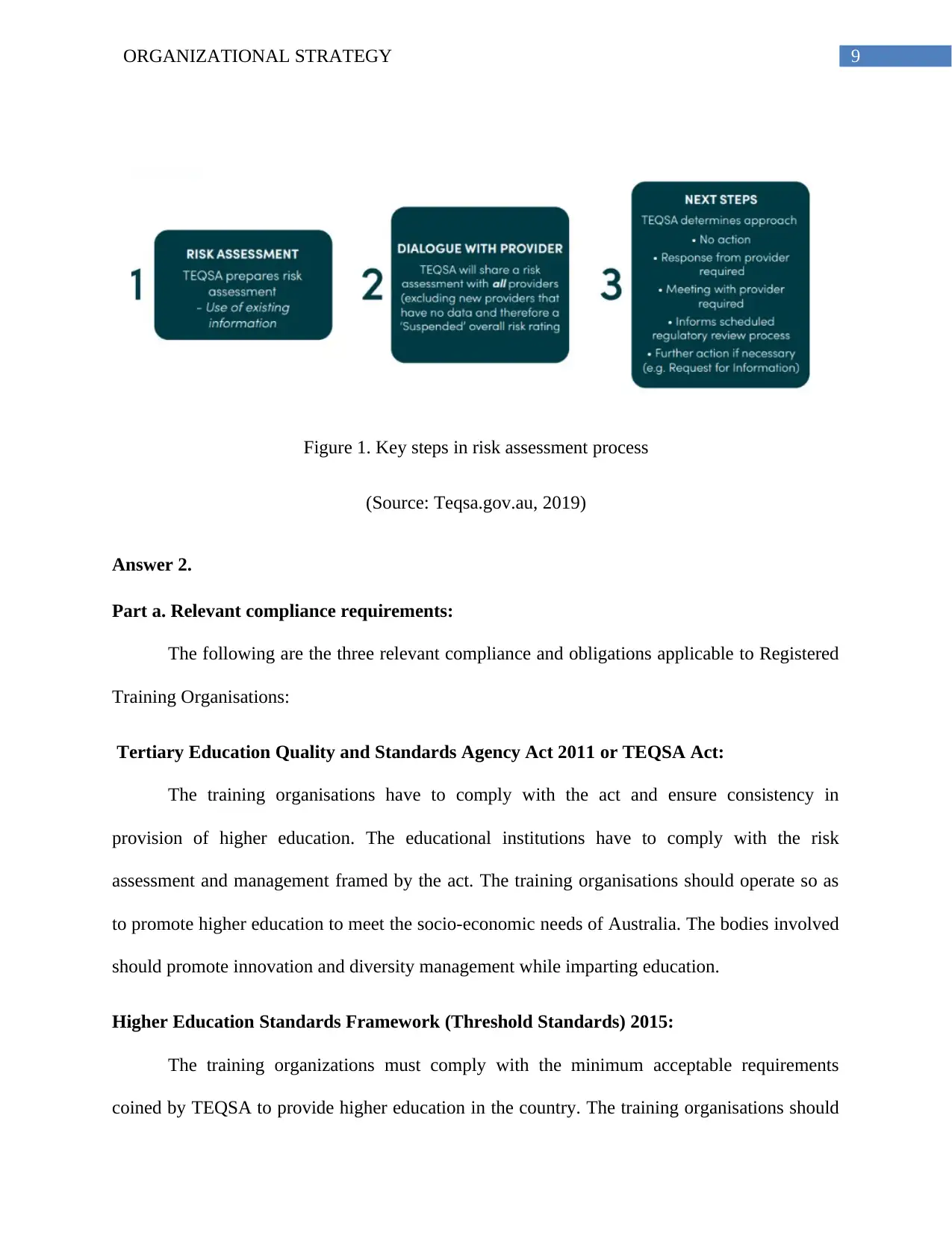
9ORGANIZATIONAL STRATEGY
Figure 1. Key steps in risk assessment process
(Source: Teqsa.gov.au, 2019)
Answer 2.
Part a. Relevant compliance requirements:
The following are the three relevant compliance and obligations applicable to Registered
Training Organisations:
Tertiary Education Quality and Standards Agency Act 2011 or TEQSA Act:
The training organisations have to comply with the act and ensure consistency in
provision of higher education. The educational institutions have to comply with the risk
assessment and management framed by the act. The training organisations should operate so as
to promote higher education to meet the socio-economic needs of Australia. The bodies involved
should promote innovation and diversity management while imparting education.
Higher Education Standards Framework (Threshold Standards) 2015:
The training organizations must comply with the minimum acceptable requirements
coined by TEQSA to provide higher education in the country. The training organisations should
Figure 1. Key steps in risk assessment process
(Source: Teqsa.gov.au, 2019)
Answer 2.
Part a. Relevant compliance requirements:
The following are the three relevant compliance and obligations applicable to Registered
Training Organisations:
Tertiary Education Quality and Standards Agency Act 2011 or TEQSA Act:
The training organisations have to comply with the act and ensure consistency in
provision of higher education. The educational institutions have to comply with the risk
assessment and management framed by the act. The training organisations should operate so as
to promote higher education to meet the socio-economic needs of Australia. The bodies involved
should promote innovation and diversity management while imparting education.
Higher Education Standards Framework (Threshold Standards) 2015:
The training organizations must comply with the minimum acceptable requirements
coined by TEQSA to provide higher education in the country. The training organisations should
Paraphrase This Document
Need a fresh take? Get an instant paraphrase of this document with our AI Paraphraser
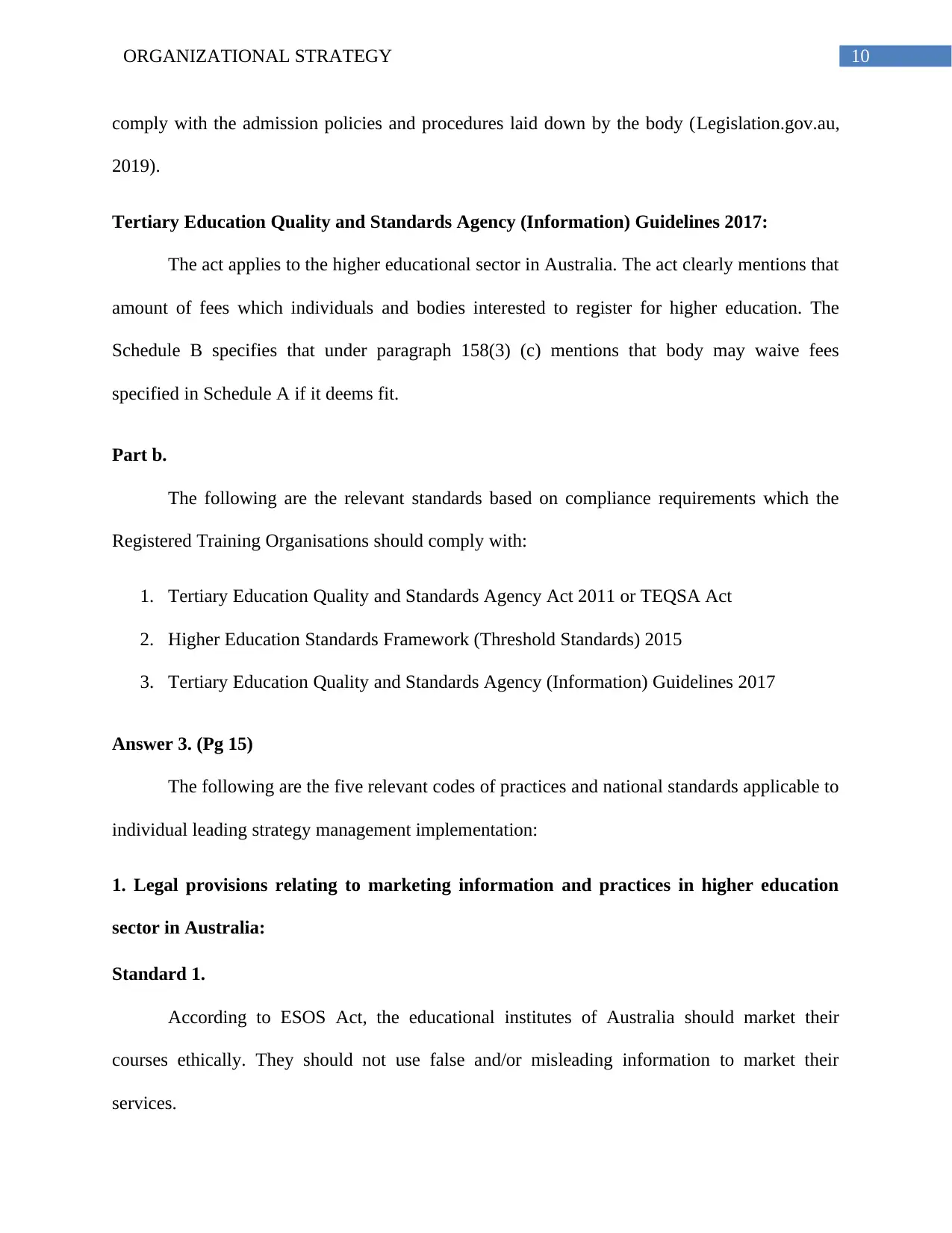
10ORGANIZATIONAL STRATEGY
comply with the admission policies and procedures laid down by the body (Legislation.gov.au,
2019).
Tertiary Education Quality and Standards Agency (Information) Guidelines 2017:
The act applies to the higher educational sector in Australia. The act clearly mentions that
amount of fees which individuals and bodies interested to register for higher education. The
Schedule B specifies that under paragraph 158(3) (c) mentions that body may waive fees
specified in Schedule A if it deems fit.
Part b.
The following are the relevant standards based on compliance requirements which the
Registered Training Organisations should comply with:
1. Tertiary Education Quality and Standards Agency Act 2011 or TEQSA Act
2. Higher Education Standards Framework (Threshold Standards) 2015
3. Tertiary Education Quality and Standards Agency (Information) Guidelines 2017
Answer 3. (Pg 15)
The following are the five relevant codes of practices and national standards applicable to
individual leading strategy management implementation:
1. Legal provisions relating to marketing information and practices in higher education
sector in Australia:
Standard 1.
According to ESOS Act, the educational institutes of Australia should market their
courses ethically. They should not use false and/or misleading information to market their
services.
comply with the admission policies and procedures laid down by the body (Legislation.gov.au,
2019).
Tertiary Education Quality and Standards Agency (Information) Guidelines 2017:
The act applies to the higher educational sector in Australia. The act clearly mentions that
amount of fees which individuals and bodies interested to register for higher education. The
Schedule B specifies that under paragraph 158(3) (c) mentions that body may waive fees
specified in Schedule A if it deems fit.
Part b.
The following are the relevant standards based on compliance requirements which the
Registered Training Organisations should comply with:
1. Tertiary Education Quality and Standards Agency Act 2011 or TEQSA Act
2. Higher Education Standards Framework (Threshold Standards) 2015
3. Tertiary Education Quality and Standards Agency (Information) Guidelines 2017
Answer 3. (Pg 15)
The following are the five relevant codes of practices and national standards applicable to
individual leading strategy management implementation:
1. Legal provisions relating to marketing information and practices in higher education
sector in Australia:
Standard 1.
According to ESOS Act, the educational institutes of Australia should market their
courses ethically. They should not use false and/or misleading information to market their
services.

11ORGANIZATIONAL STRATEGY
Standard 2.
According to ESOS Act, the act should consider that the Australian universities should
recruit students as per the act should ensure recruitment of students as per the act.
Standard 3.
The ESOS Act prescribes the education institutes to form written agreements pertaining
to enrolment of students.
Standard 4.
The ESOS Act mandates that education agents of the Australian higher education
institutes should present the institutes they represent ethically and honestly. The agents should
provide accurate information to the student to protect the interests of the latter.
Standard 5.
The minor students or students below the age of 18 years of age seeking to obtain
education in Australia should comply with the legislative or regulatory norms.
Answer 4. (pg 15)
The technology and systems requirement to support the learning strategy of an
organisations would consist of computer, internet, teleconferencing facility and cloud computing.
The technology would aid in faster communication between the management, the departmental
heads and the employees. The technology would enable the departmental heads obtain feedbacks
from the employees on the benefits they are deriving from learning strategies. This would enable
them to measure the outcomes of the learning strategies and form future learning strategies.
Answer 5.(pg 15)
The two organisational theories are as follows:
Standard 2.
According to ESOS Act, the act should consider that the Australian universities should
recruit students as per the act should ensure recruitment of students as per the act.
Standard 3.
The ESOS Act prescribes the education institutes to form written agreements pertaining
to enrolment of students.
Standard 4.
The ESOS Act mandates that education agents of the Australian higher education
institutes should present the institutes they represent ethically and honestly. The agents should
provide accurate information to the student to protect the interests of the latter.
Standard 5.
The minor students or students below the age of 18 years of age seeking to obtain
education in Australia should comply with the legislative or regulatory norms.
Answer 4. (pg 15)
The technology and systems requirement to support the learning strategy of an
organisations would consist of computer, internet, teleconferencing facility and cloud computing.
The technology would aid in faster communication between the management, the departmental
heads and the employees. The technology would enable the departmental heads obtain feedbacks
from the employees on the benefits they are deriving from learning strategies. This would enable
them to measure the outcomes of the learning strategies and form future learning strategies.
Answer 5.(pg 15)
The two organisational theories are as follows:
⊘ This is a preview!⊘
Do you want full access?
Subscribe today to unlock all pages.

Trusted by 1+ million students worldwide
1 out of 33
Related Documents
Your All-in-One AI-Powered Toolkit for Academic Success.
+13062052269
info@desklib.com
Available 24*7 on WhatsApp / Email
![[object Object]](/_next/static/media/star-bottom.7253800d.svg)
Unlock your academic potential
Copyright © 2020–2025 A2Z Services. All Rights Reserved. Developed and managed by ZUCOL.




